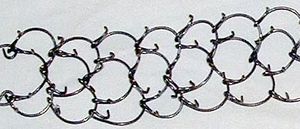Cilice: Difference between revisions
No edit summary |
m (Text replacement - "{{cat2|" to "{{cat|") |
||
| Line 15: | Line 15: | ||
{{wr}} | {{wr}} | ||
{{basic terms}}{{ | {{basic terms}}{{cat|Clothing|SAOTK}} | ||
{{footer}} | {{footer}} | ||
Latest revision as of 07:37, 27 June 2022
A cilice was originally a garment or undergarment made of coarse cloth or animal hair (also called a hairshirt). The word is pronounced "SILL-iss" and derives from the Latin cilicium, a covering made of goat's hair from Cilicia, a Roman province in south-east Asia Minor.
Cilices have been worn at various times in the history of the Christian faith for the purposes of the mortification of the flesh and for penance.
Hairshirts
A hairshirt, generally woven from goats' hair and worn close to the skin, is very itchy and therefore uncomfortable. It was worn either visibly or as an undergarment, hidden under regular clothing, When worn continuously, it could form a breeding-ground for lice, which would have increased the discomfort. Hairshirts were worn by ascetics, saints, monks, and lay persons.
Spiked metal belts or chains
In more recent times the hairshirt was replaced by spiked metal belts or chains that were worn strapped tight around the bare upper thigh to produce intense pain, especially when sitting. Many religious orders within the Roman Catholic Church have used this kind of cilice as a form of "corporal mortification". In recent years it has also become known as a practice of numeraries (celibate lay people) of Opus Dei.
See also
- More information is available at [ Wikipedia:Cilice ]
Chat rooms • What links here • Copyright info • Contact information • Category:Root
